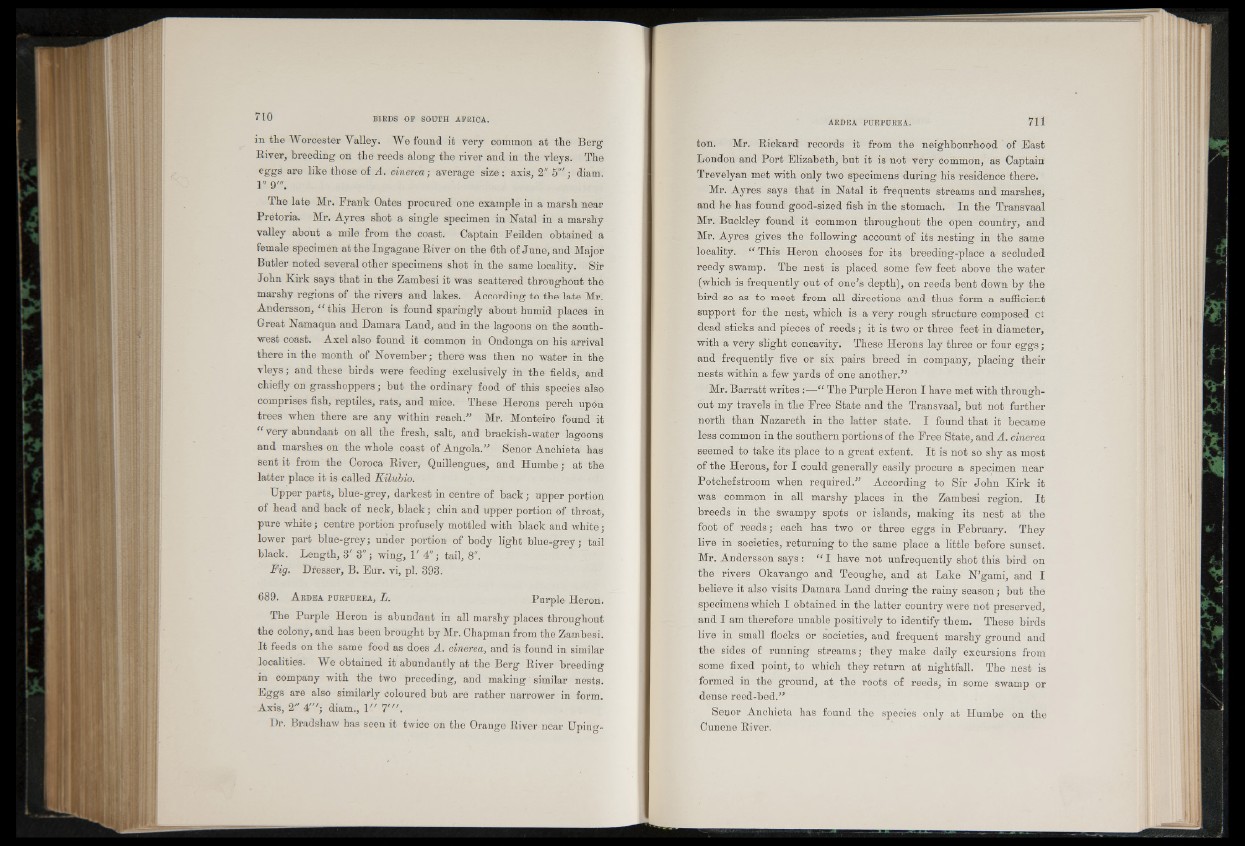
in the Worcester Valley. We found it very common at the Berg
River, breeding on the reeds along the river and in the vleys. The
eggs are like those of A. cinerea-, average size: axis, 2" ; diam.
1*9".
The late Mr. Frank Oates procured one example in a marsh near
Pretoria. Mr. Ayres shot a single specimen in Natal in a marshy
valley about a mile from the coast. Captain Feilden obtained a
female specimen at the Ingagane River on the 6th of June, and Major
Butler noted several other specimens shot in the same locality. Sir
John Kirk says that in the Zambesi it was scattered throughout the
marshy regions of the rivers and lakes. According to the late Mr.
Andersson, “ this Heron is found sparingly about humid places in
Great Namaqua and Bamara Land, and in the lagoons on the southwest
coast. Axel also found it common in Ondonga on his arrival
there in the month of November; there was then no water in the
vleys; and these birds were feeding exclusively in the fields, and
chiefly on grasshoppers; but the ordinary food of this species also
comprises fish, reptiles, rats, and mice. These Herons perch upon
trees when there are any within reach." Mr. Monteiro found it
“ very abundant on all the fresh, salt, and brackish-water lagoons
and marshes on the whole coast of Angola." Senor Anchieta has
sent it from the Coroca River, Quillengues, and Humbe; at the
latter place it is called Kilubio.
Upper parts, blue-grey, darkest in centre of back; upper portion
of head and back of neck, black; chin and upper portion of throat,
pure white; centre portion profusely mottled with black and white;
lower part blue-grey; under portion of body light blue-grey; tail
black. Length, 3' 3"; wing, 1' 4"; tail, 8".
Fig. Dresser, B. Bur. vi, pi. 393.
689. A rdea purpu r ea , L. Purple Heron.
The Purple Heron is abundant in all marshy places throughout
the colony, and has been brought by Mr. Chapman from the Zambesi.
It feeds on the same food as does A. cinerea, and is found in similar
localities. We obtained it abundantly at the Berg River breeding
in company with the two preceding, and making similar nests.
Eggs are also similarly coloured but are rather narrower in form.
Axis, 2" 4"'; diam., 1" 7'".
Dr. Bradshaw has seen it twice on the Orange River near Upington.
Mr. Rickard records it from the neighbourhood of East
London and Port Elizabeth, but it is not very common, as Captain
Trevelyan met with only two specimens during his residence there.
Mr. Ayres says that in Natal it frequents streams and marshes,
and he has found good-sized fish in the stomach. In the Transvaal
Mr. Buckley found it common throughout the open country, and
Mr. Ayres gives the following account of its nesting in the same
locality. “ This Heron chooses for its breeding-place a secluded
reedy swamp. The nest is placed some few feet above the water
(which is frequently out of one’s depth), on reeds bent down by the
bird so as to meet from all directions and thus form a sufficient
support for the nest, which is a very rough structure composed ct
dead sticks and pieces of reeds; it is two or three feet in diameter,
with a very slight concavity. These Herons lay three or four eggs;
and frequently five or six pairs breed in company, placing their
nests within a few yards of one another."
Mr. Barratt writes :—“ The Purple Heron I have met with throughout
my travels in the Free State and the Transvaal, but not further
north than Nazareth in the latter state. I found that it became
less common in the southern portions of the Free State, and A. cinerea
seemed to take its place to a great extent. It is not so shy as most
of the Herons, for I could generally easily procure a specimen near
Potchefstroom when required." According to Sir John Kirk it
was common in all marshy places in the Zambesi region. It
breeds in the swampy spots or islands, making its nest at the
foot of reeds; each has two or three eggs in February. They
live in societies, returning to the same place a little before sunset.
Mr. Andersson says : “ I have not unfrequently shot this bird on
the rivers Okavango and Teoughe, and at Lake N’gami, and I
believe it also visits Damara Land during the rainy season; but the
specimens which I obtained in the latter country were not preserved,
and I am therefore unable positively to identify them. These birds
live in small flocks or societies, and frequent marshy ground and
the sides of running streams; they make daily excursions from
some fixed point, to which they return at nightfall. The nest is
formed in the ground, at the roots of reeds, in some swamp or
dense reed-bed.”
Seuor Anchieta has found the species only at Humbe on the
Cunene River.